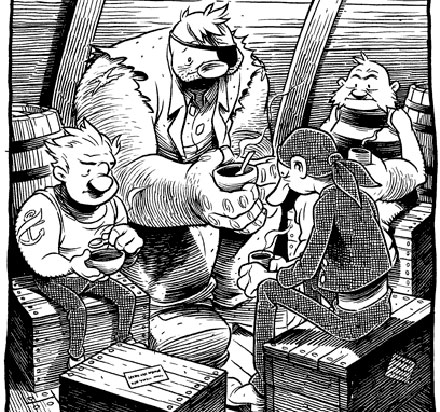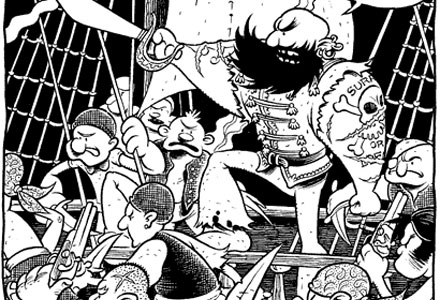This is what happens when Techland goes to the comic book store: we end up talking about what we picked up. This week, Douglas Wolk, Evan Narcisse, Mike Williams and Graeme McMillan discuss The Last Phantom #1 and Set to Sea.
DOUGLAS: The Last Phantom: Oh God. The only thing I can think of is the old joke about the guide warning his charges about the ceaseless drumbeat they’re hearing in the jungle–insert about five minutes of buildup here–“But remember–it’s very, very bad if the drums stop.” “Wh-what happens then?” “…Bass solo.”
My exposure to the Phantom is pretty minimal–I think I read a couple of comic books and a couple of episodes of the newspaper strip 30 years or so ago. (As I recall, Don Newton drew a couple of the comics, and I always had a real fondness for anything Don Newton did.) But what is this stultifying load of color-by-numbers savage-jungle/action-hero-legacy codswallop, and is there a reason I’d begin to care about it if I knew anything about the Phantom? Does every trademark with a costume need to be hauled up and mechanically serviced?
(More on Techland: The Comic Book Club: The Unwritten and Ultimate Avengers 3)
EVAN: Douglas, I probably only know about as much as you do about the Phantom: Created by Lee Falk, white guy in the jungle, the guns and the skull ring, one of the earliest legacy characters in comics. You can see that they were trying to do a history-free, continuity-lite approach to the Phantom, for fear of alienating people who aren’t steeped in the lore.
But the problem with this kind of gamble is that you can lose hold of what differentiates the character. So, in this case, either embrace the purple leotard or don’t. This bathed-in-blood with guyliner look comes off as a bad compromise, especially since the purple looks like the blood’s colored wrong. Also, it’s way gorier than previous iterations of the Phantom. Does that fit the mystique?
And, yeah: the savagery. Let’s not shy away from the fact that there’s horrific political violence on the continent of Africa and also let’s not shy away from using it in fiction. But, man, you really need to set up context. The creative team doesn’t do that nearly enough here. There are enough codewords and images–“yellowcake,” “disease,” “political pressure,” oil and diamond icons–to make it seem “modern,” but all that feels perfunctory and cheap.
This does feel like trademark service. Kit Walker tells us he’s the guardian of Bengali and its people. Really? How? Why? All we get is he’s the head of a charitable organization. And we get the Bengali president invoking the Ghost Who Walks lore. How are we supposed to know how he knows that? What is that supposed to mean to new readers? That said, I did like the art.

Also, when I was reading The Last Phantom, I kept on flashing back to the infinitely better Unknown Soldier reboot that came from Vertigo recently. It also re-interpreted a pre-existing mythos in a modern context, with lots of ramped-up violence and real world political echoes. But it couched it all in a strongly delineated framework and great character dynamics full of contradictions.
(More on Techland: The Comic Book Club: Wonder Woman and Action Comics)
GRAEME: YES. This Phantom reboot reminds me, more than anything, of Vertigo’s Unknown Soldier – It’s as if they’re trying to do the same thing, but without a willingness to do more than give lip service to the political reality and ambiguity that Unknown Solider readily inhabits.
It’s a shame; I really liked Scott Beatty’s refit of Buck Rogers, also for Dynamite, and there he managed to balance “reboot for new readers/callouts to old stuff for old readers” much better than it’s handled here. Even the dialogue was better there, I feel. There’s just something about starting a Phantom book with the line “They call it the ‘Jungle Telegraph,’ and it warns of impending DOOM.” Is that recognition of the cliche, or just being cliched?
MIKE: My exposure to the Phantom was the movie from the 90’s. After reading this issue, though, I feel the need to go back and look up some original stuff, since this can’t be what the franchise is all about. Two things stood out to me in this book, the violence and the art–neither for good reasons.
The violence is unavoidable for this story. By the way, this story is an origin story–at least that’s how it reads to me. The fact that Kit is from a long line of ass-kickers is coincidence. A set of cookie-cutter thug mercs attacks Kit’s family compound so that a subordinate can take over a charity organization? A broke charity organization? It’s all paper-thin excuses to have his family killed. These guys go out of their way to murder a horse!
I agree with just about everyone that as an Alex Ross cover the ‘blood uniform’ works well, but as interior art, not so much. We’ll see how this series goes, but are we expected to believe that every time he is going to Phantom up he’ll break out the gun-belt loincloth and a gallon of blood? I know that a purple body suit and a domino mask can be a tough sell for a modern-day reboot, but what we get here is not the way to go.
GRAEME: I don’t know if this series is necessarily built for the long haul. Not only is there the “I have to become the Phantom again – WHERE IS MY BLOOD COSTUME?” problem, but the title suggests that this is either a bridge to a n ongoing “Now he’s the Phantom” book with, presumably, a new status quo and more durable costume, or a one-off revenge story.
MIKE: Please be a one-off revenge story.
DOUGLAS: Set to Sea, on the other hand, is the real thing: a one-off nautical action book (a hardcover version of Drew Weing’s sweet, lively web-comic) that’s a real pleasure to look at and linger over. Every panel-as-page just radiates joy in drawing. It owes a bit to “Popeye,” obviously (and I vaguely remember something E.C. Segar once said about how all he really knew about Popeye’s past was that there was a lot of pain in it), but I think the central moment of the story is the one where the protagonist realizes that his life is actually much better for all the suffering he’s endured.

MIKE: A nautical action book? It’s interesting to hear you say that, because that’s not really the way that I thought about it. Sure, there’s the big scene where the merchant ship our unnamed protagonist toils on is boarded by pirates, but other than that it wasn’t the action that sold me. To be fair, it was the art that sold me. When I opened this book and saw the first page, I immediately thought “Oh, a splash page.” Then I turned it over and saw another, and then another. I positively adore this format.
(More on Techland: “Batwoman: Elegy” and “Werewolves of Montpellier”)
As to the Popeye pedigree, I thought that as well, but I was looking at one of the two kidnappers in the beginning of the book when I thought it–the ham-fisted heavy with Olive Oyl-like legs. It was stylistic choices such as that character that stood out so vividly against the detailed and heavily crosshatched background work. I could pull half or more of the pages in this book and hang them as wall art.

DOUGLAS: Now I’m imagining a contemporary revival of Popeye with Alex Ross covers, with a hideously scarred one-eyed hero fighting Somali pirates, Alice the Goon tearing people in half… “They stole his Swee’Pea. Now the sailor man will have his revenge.”
MIKE: Back to the action, though. The scenes that I lingered on the longest were some of the quieter moments, as when the big lug throws his journal into the water, proclaiming his uninformed work “ridiculous.” Also great was the two-page sequence where a sailor falls from the rigging and then is silently mourned by his mates down below.
The lesson preached here is that no amount of clever wordplay can ever replace life experience? I wouldn’t call it a parable, as I’m not sure that spouting poetry about things you know nothing of is all that morally corrupt. But it does have that children’s storybook quality about it. Not in the way it’s executed, but in the fiber of the story. I don’t know that many children’s books that feature bar fights.
I gave this book one of my highest distinctions. I made my girlfriend read it.
EVAN: Man… this book! It starts off all pining and lonesome.
And then our nameless hero gets shot in the eye.
And all of it still works. That moment of violence doesn’t break the book. I think that’s because Weing creates a wonderful modulation of tone throughout Set to Sea. You can hear the book going from quiet to loud and back and forth again. That scene where Big Lug looks into the bookstore and sighs just about killed me. A din almost rises up from the page when that big battle scene happens; despite the fact that the panels have nary a sound effect, the clatter of swords and booming cannons comes across as clear as day. I also love that you can pinpoint the exact moment that Big Lug finds his poetry: it’s when they’re drinking after repelling the invading ship and the mates are toasting each other. The long wordless chunk in the third act doesn’t come across as a gimmick either; it’s just what it needs to be. Maybe it’s corny to call a book about a would-be poet lyrical, but that’s exactly what Set to Sea is.
(More on Techland: The Comic Book Club: X-Men, Superman and Parker)
GRAEME: Agreed with all of you. Set to Sea is just beautiful, emotional in all the right ways, and mixed with unexpected moments to pull it away from sugary sentiment and tweeness – Dude gets shot in the eye! Man! There’s such a gentleness here, so much heart, that it’s completely compelling, and the way Weing structured it, a panel a page, makes the reading experience wonderfully slow, to match the story.
What I also loved about it was how sparse it is; so much is brought to it by the reader, especially in terms of the implication of drinking/fighting/living that we don’t see, as time passes. There’s no hitting over the head with “This is what is important!” but it’s left up to us, which makes it more meaningful, somehow. I just really, really loved this book. Like you said, Douglas, this is the real thing.

